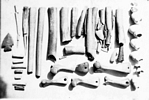Peck 2
Overview
During the spring of 1937, from March 2 to May 18, a WPA field crew excavated two overlapping palisaded village components at the Peck 2 site (36 So 8). This site was located at the Meyersdale fairgrounds within the infield and at the eastern end of a race track. Each of Peck 2's village occupations had their own small cemetery. Peck 2-1, the smaller occupation, has been partly destroyed by construction of the racetrack. This village component dates to ca. 1150 A.D. and is one of the earliest known villages in Somerset County. The 23 dwellings at this site were inhabited by around 140 people. The larger occupation, Peck 2-2, is the last village known to have been inhabited in Somerset County, dating to around ca. 1540 A.D. Approximately 258 people occupied this village components 32 dwellings. Some of the people organized themselves around a courtyard set aside from the remainder of the village that had its own central post.
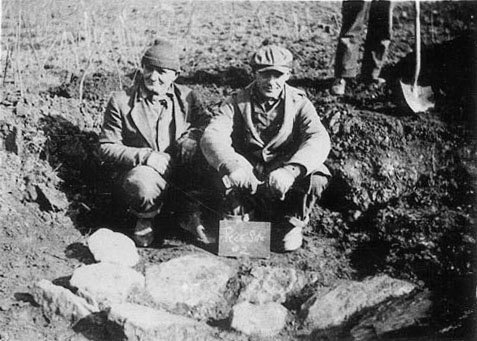
Two members of field crew at Peck 2 sit near a rock-covered pit.
Site Maps
Click images for larger version.
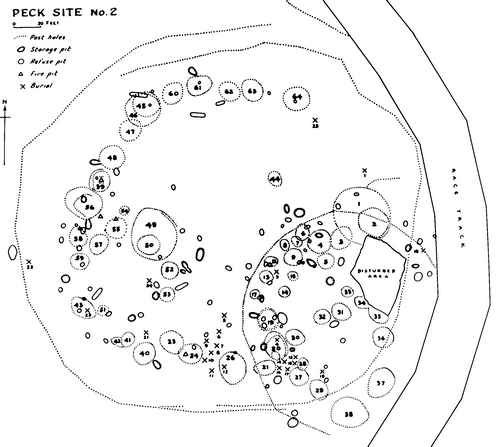
Site map of Peck 2 produced by Edgar Augustine in 1942.
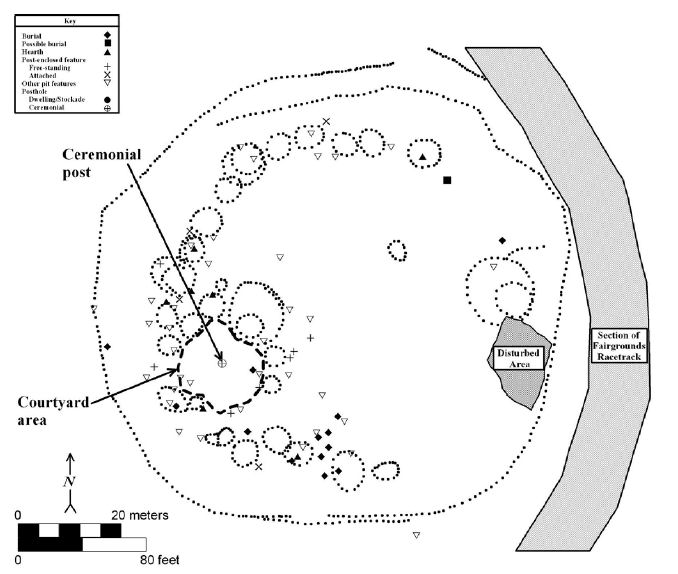
Map of Peck 2-2 with courtyard group indicated.
Artifact Images
All images derived from original field notes dating to 1937. Click image for larger version.
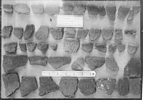
Ceramic vessel rims from Peck 2
Site Scenes
All images derived from original field notes dating to 1937. Click image for larger version.
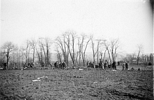
Visitors view excavations at Peck 2

Excavating a feature at Peck 2
References
Augustine, Edgar
1938 Important Research on Peck and Martz Rock Shelter Site in Somerset County. Pennsylvania Archaeologist 8 (4):83-88.
Hart, John P.
1993 Monongahela Subsistence-Settlement Change: The Late Prehistoric Period in the Lower Upper Ohio Valley. Journal of World Prehistory 7:71-120.
Means, Bernard K.
1998 Archaeological Past and Present: Field Methodology from 1930s Relief Excavations in Somerset County, Pennsylvania and its Relevance to Modern Archaeological Interpretations. Journal of Middle Atlantic Archaeology 14:39-63. Available online.
1999 Monongahela Mortuary Practices in Somerset County, Pennsylvania: Observations and Implications. Pennsylvania Archaeologist 69 (2):15-44.
2002 Revisiting Mary Butler's "Three Archaeological Sites in Somerset County, Pennsylvania" for Continuing Insights into Depression-era Archaeology in Southwestern Pennsylvania and Late Prehistoric Monongahela Social Organization. Pennsylvania Archaeologist 72 (2): 8-46.
2003 Deliver Me From Mononga-Hell: Thinking Beyond the Culture History Paradigm to Examine the Temporal and Spatial Parameters of Somerset Monongahela Village Settlements. Journal of Middle Atlantic Archaeology 19:37-58.
2006 Circular Reasoning: Drawing on Models of Ring-shaped Village Spatial Layouts To Examine Villages in Late Prehistoric Pennsylvania. Unpublished Ph.D. dissertation, Department of Anthropology, Arizona State University, Tempe. University Microfilms, Ann Arbor.
2007 Circular Villages of the Monongahela Tradition The University of Alabama Press, Tuscaloosa.
